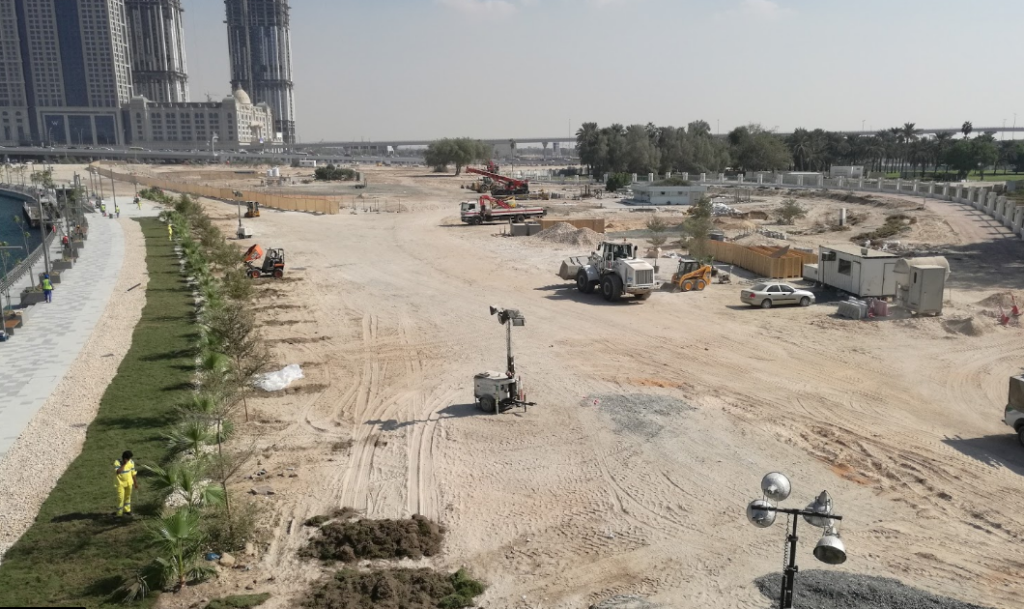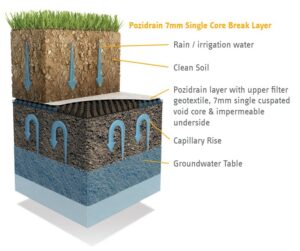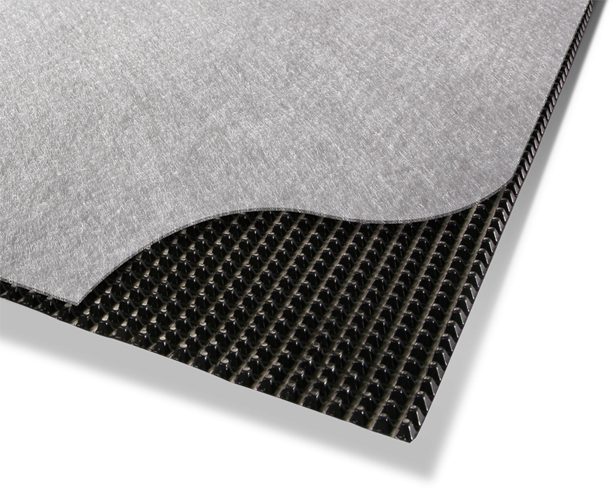In deserts and arid regions, the groundwater is often saline and the water table can be relatively close to the surface. The capillary rise above the water table brings dissolved salts near to the surface of the ground. This results in severe problems for vegetation and the foundations of building structures.
Landscaping within modern developments in arid regions is particularly at risk. Most vegetation is intolerant of even slightly saline water (3-6 g/litre). Saline moisture must be prevented from reaching the root system of the vegetation. Similarly, it is important that irrigation water has minimal salt content to minimise the risk of salination of the soil (<0.5 g/litre no risk; 0.5-2g/litre moderate risk). For vegetation to survive, it is essential that there is a barrier between the saline ground and the clean ground and that this barrier also provides good drainage.

Building foundations of stone and reinforced concrete are designed for long-term strength, but this is compromised when saline moisture attacks the concrete. Chloride ions within saline moisture are drawn into stone and concrete where the resultant chemical reaction causes expansion, spalling and weakening of the foundations. It is therefore important that there is a barrier between saline ground and the clean ground in which foundations are constructed.
An effective barrier is to provide a capillary break layer between saline ground and clean ground. The capillary break layer creates a void across which capillary rise of saline moisture is prevented. It is essential that the capillary break layer is installed above the highest level of the water table, so that the void is never totally saturated by ground water and that the capillary break has high in-plane flow capacity so as to remove sub-surface and irrigation water that enters through the clean ground above.
High performance geocomposites, such as Salt Break, are the preferred choice for the salt barrier capillary break layer. This is because the cuspated core maintains an open void, with high compressive strength and excellent support provided to the geotextile surfaces under the action of soil pressure as tested to ISO 12958 with SOFT PLATENS. The performance is enhanced with the lower side of the cuspated core providing a practically impermeable barrier to the rising saline moisture.

The capillary break layer is typically laid at a shallow gradient (eg. 3%) and the in-plane flow capacity will be significantly lower than at a hydraulic gradient (HG) of 1 (ie. vertical). The volume of irrigation water coming down through the soil above will be governed either by the irrigation rate or by the permeability of the soil. If the soil permeability is 1 x 10-6 m/s this equates to a water volume of 1 x 10-3 l/m²·s. In a 100m length of salt barrier, this creates an equivalent flow of 0.1 l/m·s. If the soil permeability is 1 x 10-5 m/s then there would be 10 times more water from the soil.
Design calculations, taking into consideration the in-plane flow capacity and the air-void volume of the break layer, should be carried out based on the expected flow in the product to avoid saturation in the capillary break layer. Saturation in the capillary break layer will mean the “void” is interrupted and the saline moisture can make its way through to the topsoil and plants.
ABG suggests not more than 30% of the in-plane flow capacity of the drainage layer is used to drain the excessive water, and that realistic SOFT/SOFT boundary conditions (as per EN 12985) are used to establish the in-plane flow capacity of the product. Please contact our technical advisors for detailed information and examples.
The ABG Salt Barrier features a unique system for “one way overlapping” which allows “flushing” of lower saline capillary saline moisture back down to the water table via the collected topsoil water, thus further diluting the saline content of the sub-surface.

Typical Client Profile
- Landscape Architects
- Landscaping Contractors
- Coastal / Marine Engineers
- Saltwater Canal and River Engineers
- Consulting Engineers
- Ministries of Public Affairs



